Tips by Peg Smith, UC Master Gardener-Yolo
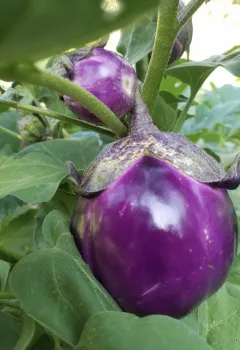
May is the month to get all these wonderful summer vegetables planted: tomatoes, peppers, corn, eggplant, and squash. We are all familiar with ‘summer squash’ such as zucchini, crookneck, and patty pan. But don’t be fooled by the term ‘winter squash’ (butternut, acorn, and pumpkin varieties). This terminology refers to squash that have thicker, stronger skins. Plant some winter squash now as these can be harvested, stored in a cool dry place, and eaten through the fall and winter to savor the taste of summer when the weather cools.
Be brave, try a new vegetable or different variety of a favorite vegetable from the wonderful selection available at sales and nurseries.
One of the most common questions for Master Gardeners is ‘What’s wrong with my tomatoes?’
Here’s a general troubleshooting guide for tomatoes:
Weather
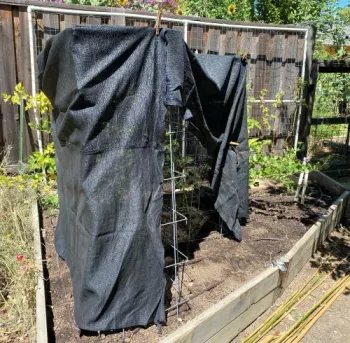
Tomatoes can be finicky, too hot or too cold, fruit setting is delayed. If an extended period of summer heat is forecast use an old sheet or shade cloth to cover your plants. Other causes of poor fruit set could be not enough sunlight or excess nitrogen (always follow the directions for fertilizer application).
Water
Consistency is the key. Deep soak one to two times a week, depending on the daytime high temperatures. Mulch the soil, a three to four-inch layer of mulch helps reduce the evaporation of water from the soil and reduces soil temperature around the roots.
Pests

The tomato hornworm is the most common pest, a voracious feeder that devours both leaves and fruits. Although we may curse the damage done to tomatoes by the hornworm in its life cycle, after pupation and metamorphosis, a beautiful hawkmoth emerges. Check for small black particles of feces (frass) on tomato plants that are damaged by chewing. Examine closely the leaves, stems and fruit above the frass, small hornworms can be hard to see, remove and dispose of any found. Bt (Bacillus thuringiensis) is a bacterium that is environmentally safe for humans and animals and is most effective as a foliar spray when caterpillars are small.
PLEASE NOTE: After caterpillars consume Bt they stop eating, this is true for all caterpillars, confine any spray to tomatoes and avoid spraying host plants for other butterfly and moth pollinators you wish to encourage to the garden.
Yellow spots on ripe tomatoes usually indicates damage from the feeding mouth parts of stink bugs or leaffooted bugs. Damage on green tomatoes appears as dark pinpricks surrounded by a light discolored area. The light discolored area turns yellow as the fruit ripens. Stink bugs and leaffooted bugs emerge in spring. Clear old wood, ground cover and weedy areas around vegetable-growing areas in early spring to help control populations. The fruit is edible.
Soil Borne Diseases
Leaves on a branch or stem may become yellow or brown, then wilt and die. This is usually caused by soil fungi that affect the vascular system of the plant, restricting the flow of water. There are two main culprits, Fusarium and Verticillium. When stressed with the heat of summer, plants cannot deliver water from soil to foliage and the damage becomes more evident.
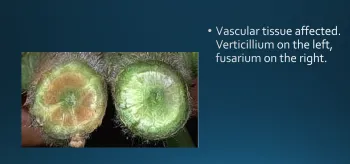
Fusarium Wilt: Fusarium thrives in warm soil. Damage is usually noticed on one side or branch and spreads through the plant which eventually dies.
Verticillium Wilt: Verticillium prefers cooler soil temperatures. Damage begins on older leaves; the yellowing first develops between the main stems of the leaves. With the heat of summer and fruit load the plant will eventually die.
Both Fusarium and Verticillium are endemic in soils. Growing seeds or transplants that are labeled with V, F or VF indicates that the variety is resistant to one or both fungi and should be more successful. Soil solarization (UV-resistant clear plastic over the soil, anchored at the edges, for six to eight weeks in summer) can be effective in reducing both Fusarium and Verticillium in the soil. Crop rotation is important; tomatoes, potatoes, peppers, and eggplant should not be grown repeatedly in the same soil. Rotate squash, corn, etc. with these vegetables. Any plants pulled showing signs of wilt should be discarded in the garbage. Because of the reduced foliage, fruits may develop sunscald, the fruit may need trimming but is edible.
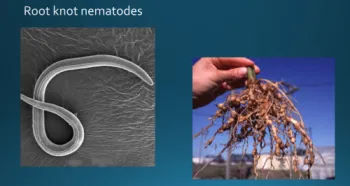
Nematodes are microscopic round worms that are present in the soil and feed on the roots of plants. Affected tomato plants may have reduced growth, lack vigor and wilt. Lower leaves will begin to turn yellow and brown. When pulled the plant roots show small beads or swellings from the nematodes. Plants should be pulled and disposed of in the garbage. Some tomato varieties are nematode resistant and will be labelled with ‘N’. Soil solarization will reduce the nematode population. Avoid planting nematode-susceptible vegetables such as tomatoes, potatoes, peppers, and eggplant in that area of soil. Brassicas, corn, and squash rotated with a cover crop of either buckwheat in the summer or legumes in the winter can over time reduce the nematode problem.
Blossom End Rot
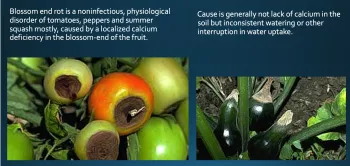
There are a group of diseases called ‘abiotic’ meaning they are caused by conditions, not disease, often too little or too much of something. Blossom end rot begins as a small brown area where the flower has dried and dropped from the tomato. This area enlarges into a region of brown leathery tissue as the fruit ripens. The cause is a low level of calcium in the fruit, a contributing factor is consistency of water availability during blossom set and fruit development. Our Yolo County soils are predominantly alkaline with plenty of available calcium. Calcium is moved through the plant more evenly and effectively when the soil moisture is consistently replenished. Deep soaking at regular intervals is preferable to a daily light surface watering and will help prevent blossom end rot. Excess fertilizer, especially an ammonia-based fertilizer, will interrupt the soil chemistry and alter the availability of calcium for uptake for the plants. The affected fruit is edible.
Support
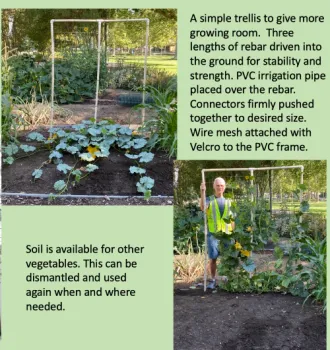
Be sure to stake and support tomatoes as they grow, good airflow and fruit lifted off the ground will reduce disease.
Weeds
Tackle the last of the spring weeds – you won’t regret it. By controlling weeds in spring, the flower heads do not mature and scatter viable seeds to add to the soil seed bank, ready to develop the next spring when conditions are prime.
Water
Now is the time to check drip or sprinkler irrigation systems. Watch for leaks and repair. This time of the year irrigation needs can change if we have a prolonged warmer spell adjust watering as needed.
Ornamentals and Annuals
Deadhead roses as they fade. Cut stems at a 45-degree angle ¼” above a grouping of five leaves on the outside of the stem, this promotes continued bloom. To attract pollinators to the garden plant agastache, alstroemeria, bee balm, cone flower, coral bells, CA native fuchsia, honeysuckle, penstemon, and salvia. Chrysanthemums planted now will give fall color to the garden. It is not too late to plant perennial shrubs, trees, or vines. Water deeply and regularly to keep the soil moist for any first-year plants, and they should handle the summer heat. As you walk the garden cut spent blooms, this should promote continued blossom development.
Diseases and Pests
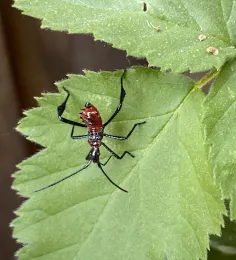
Keep a close watch for any damage from insects, slugs, or snails. To identify and treat a problem refer to UC IPM website which describes the least environmentally toxic solutions.
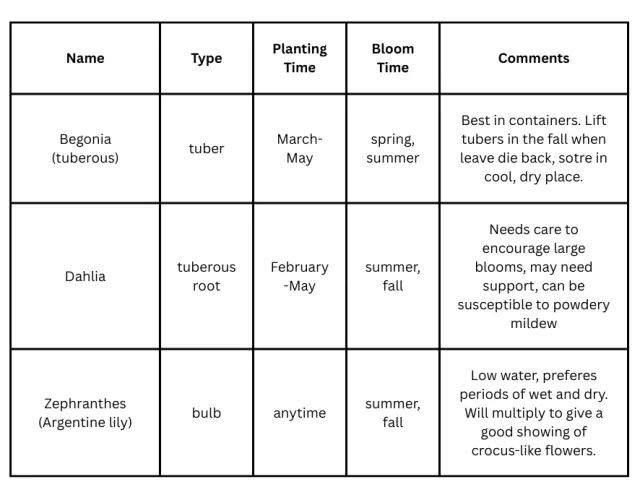
Fertilizing, Composting, and Mulching
Most plants will benefit from a spring application of compost or fertilizer. Always check the labels before applying. Excess nitrogen in the soil stimulates rapid vegetative growth, which can be structurally weak, rather than fruit or bloom. Be sure to use the fertilizer recommended for each plant type. Follow the application and timing directions—more is not better!
To help control weeds and reduce soil moisture evaporation, apply a four-inch layer of mulch around plants and to cover open dirt. Watch for small holes in the dirt; they may be from ground-nesting bees. Wait and mulch that area later to allow the emergence of the next generation of native bees. For more information, refer to the Xerces Society article on Pollinator Conservation In Yards and Gardens.
Bulbs
As blooms fade on spring bulbs, deadhead (remove blossom stalks and finished blossom heads). Cut back bulb leaves to the ground as they yellow. See the chart above.
Fruits
Squirrels may have already contributed their efforts to thinning the fruit on your trees. To thin the fruit load, remove fruit on apple, pear, peach, nectarine, and apricot trees, leaving about six inches between the remaining fruits. Fertilize citrus with a layer of compost or commercial fertilizer.
Vegetables
May is the ideal time to direct seed (about one inch deep) melons, cucumbers, summer squash, and winter squash. The seeds of these plants are large, easy to handle with fast germination and growth. If growing melons or winter squash on the ground, as fruit develops, rest the fruit on a piece of board or layer of mulch to avoid any rot from direct soil contact. These plants can also be grown vertically on a simple trellis. As melons and winter squash become heavy a simple sling of old towel or torn sheet tied to the trellis will give added support. The big advantage of trellising these vines is that it allows more space for growing other vegetable favorites. Follow the golden rule of vegetable growing through our hot summer: deep, consistent watering, and a three to four-inch layer of mulch.
Good Growing! Click on the link below to take you to the guide for May.
